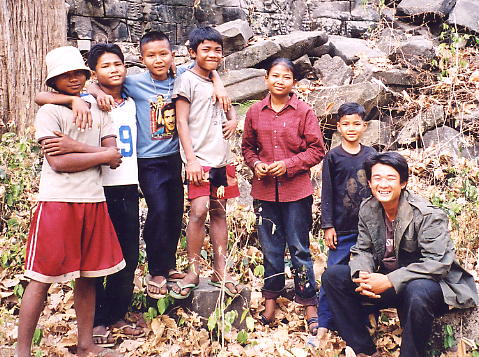
ANDYBROUWER.CO.UK
CAMBODIA TALES 2005 - JANUARY
The Banteay Chhmar experience
My
hunch proved correct. I'd visited the vast temple complex of
Banteay Chhmar, near the northwest border with Thailand, once
before in 2001, and felt that a temple of that magnitude and
importance must have other 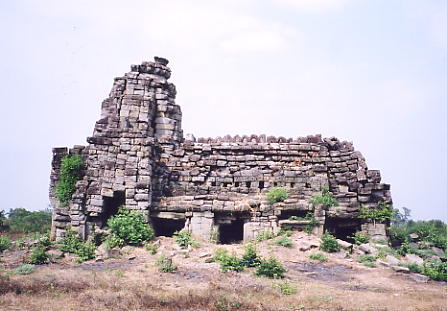 temples in the vicinity. I kept in e-mail contact
with my moto-driver from my first visit, Heang, and in preparing
for my return, he'd done some investigation at the local tourism
office in Sisophon, who'd produced a list of other temple names
close to the main site. That had certainly whetted my appetite
and I met with Heang for an hour in Siem Reap to discuss our
plans for a return visit. Heang had moved to live in Siem Reap a
few months before, hoping for a better life as a tuk-tuk driver
than in his hometown of Sisophon. His resourcefulness and
willingness had greatly impressed me and whilst I spent my last
night in Siem Reap, he'd driven his moto the 100kms back to
Sisophon to ensure he was ready for my arrival that morning.
temples in the vicinity. I kept in e-mail contact
with my moto-driver from my first visit, Heang, and in preparing
for my return, he'd done some investigation at the local tourism
office in Sisophon, who'd produced a list of other temple names
close to the main site. That had certainly whetted my appetite
and I met with Heang for an hour in Siem Reap to discuss our
plans for a return visit. Heang had moved to live in Siem Reap a
few months before, hoping for a better life as a tuk-tuk driver
than in his hometown of Sisophon. His resourcefulness and
willingness had greatly impressed me and whilst I spent my last
night in Siem Reap, he'd driven his moto the 100kms back to
Sisophon to ensure he was ready for my arrival that morning.
I'd
breakfasted at 6.30am at the HanumanAlaya, packed my bag and met
up with Rieng a little after 7am for the ride to the share-taxi
rank on the forecourt of the petrol station opposite the main
bridge over the river. The taxi drivers quoted a $4 per seat levy
for the ride to Sisophon and when Noung arrived with her parents,
the car was full and ready to leave. It was 8am. I said my
goodbyes to Rieng - who'd had a call to guide a tourist  for the next two days whilst I was out of town - and
to Noung's parents, as we shared a backseat with two older women,
with the driver and two male passengers in front. The highway to
Sisophon was busy and bumpy with only one holdup for about ten
minutes due to a bottleneck at a broken bridge. The two hour trip
gave Noung and I the opportunity to catch-up on her brother's new
job in Ou Ambel, close to Sisophon, and her own desire to seek
out a job with the same Christian charity in Siem Reap. Heang was
waiting at the market for our arrival just after 10am and I
arranged to see Noung and her brother Plon later that same
evening. Not wanting to waste any time, I booked a room at the
Neak Meas hotel ($12/night with air-con and hot water) and we
were on the road to Banteay Chhmar within twenty minutes of our
arrival. It took us two hours on the dusty road (route 69) to
cover the 40kms to Thma Puok, though thankfully the sun was
behind cloud for much of the time, and we stopped for a beef and
rice lunch at a busy restaurant opposite the police station. The
last leg of the ride took us another twenty minutes, arriving at
the entrance to the main Banteay Chhmar temple a little after
1.30pm, signing the visitors book and handing over the $3 entry
fee to the solitary policeman on duty.
for the next two days whilst I was out of town - and
to Noung's parents, as we shared a backseat with two older women,
with the driver and two male passengers in front. The highway to
Sisophon was busy and bumpy with only one holdup for about ten
minutes due to a bottleneck at a broken bridge. The two hour trip
gave Noung and I the opportunity to catch-up on her brother's new
job in Ou Ambel, close to Sisophon, and her own desire to seek
out a job with the same Christian charity in Siem Reap. Heang was
waiting at the market for our arrival just after 10am and I
arranged to see Noung and her brother Plon later that same
evening. Not wanting to waste any time, I booked a room at the
Neak Meas hotel ($12/night with air-con and hot water) and we
were on the road to Banteay Chhmar within twenty minutes of our
arrival. It took us two hours on the dusty road (route 69) to
cover the 40kms to Thma Puok, though thankfully the sun was
behind cloud for much of the time, and we stopped for a beef and
rice lunch at a busy restaurant opposite the police station. The
last leg of the ride took us another twenty minutes, arriving at
the entrance to the main Banteay Chhmar temple a little after
1.30pm, signing the visitors book and handing over the $3 entry
fee to the solitary policeman on duty.
After
an inspection of the dharmasala (rest house) near the entrance, a
welcoming committee awaited me at the ruined eastern gopura of
half a dozen cheeky teenagers, who decided to adopt me for my
visit to 'their' 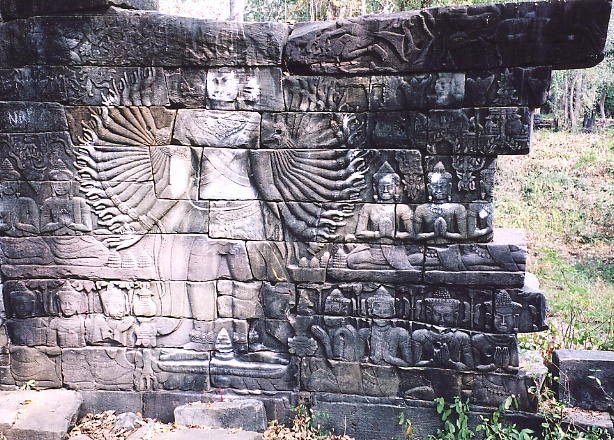 temple. The ringleader was the only girl, India
("like the country" she beamed), who was particularly
keen to practice her exceptionally wide English vocabularly,
alongwith her not so confident friends, Tout, Pranya, Toeuy, Loan
and Sophea. Even though Heang and myself had visited the temple
before, I asked my new companions to show me the best bits as we
ambled slowly around the temple complex and they picked out a
couple of carvings that I hadn't seen on my previous visit. Parts
of the temple are in pretty good condition, walls, towers and
gopuras are still standing and intact including three towers with
the wonderful giant smiling faces of the Bodhisattva
Avalokitesvara (or Jayarvarman VII depending on
temple. The ringleader was the only girl, India
("like the country" she beamed), who was particularly
keen to practice her exceptionally wide English vocabularly,
alongwith her not so confident friends, Tout, Pranya, Toeuy, Loan
and Sophea. Even though Heang and myself had visited the temple
before, I asked my new companions to show me the best bits as we
ambled slowly around the temple complex and they picked out a
couple of carvings that I hadn't seen on my previous visit. Parts
of the temple are in pretty good condition, walls, towers and
gopuras are still standing and intact including three towers with
the wonderful giant smiling faces of the Bodhisattva
Avalokitesvara (or Jayarvarman VII depending on  your point of view), some friezes and carvings are
also in good nick, whilst other areas are in ruin, large
sandstone blocks litter the floor which we used as stepping
stones, lintels and pediments are damaged, destroyed and defaced
and in the last year, one of the face towers had become unstable,
fallen and shattered into many pieces. We walked around the
outside of the enclosure wall to view the continuous bas-relief
carvings, in particular the two remaining multi-armed Lokesvara
carvings next to the western entry gopura. Originally there were
eight of these exquisite reliefs though only two, one with
thirty-two arms, the other with twenty-two, remain. Though they'd
survived intact whilst similar carvings nearby had been looted a
few years earlier (and now reside in the Phnom Penh museum), both
figures had remnants of a white chalk-like substance on them as
well as some graffiti in Khmer, whilst further along the wall,
the reliefs depicting battle scenes on land and water and a giant
Rahu monster were intermittently bathed in sunlight filtering
through the surrounding trees. Walking back through the inner
sanctuary, the birdcalls and stillness, despite the occasional
bout of laughter from my companions who couldn't keep quiet for
longer than a minute, gave the temple an undisturbed and tranquil
presence, devoid of the crowds and trappings that you find at
Angkor.
your point of view), some friezes and carvings are
also in good nick, whilst other areas are in ruin, large
sandstone blocks litter the floor which we used as stepping
stones, lintels and pediments are damaged, destroyed and defaced
and in the last year, one of the face towers had become unstable,
fallen and shattered into many pieces. We walked around the
outside of the enclosure wall to view the continuous bas-relief
carvings, in particular the two remaining multi-armed Lokesvara
carvings next to the western entry gopura. Originally there were
eight of these exquisite reliefs though only two, one with
thirty-two arms, the other with twenty-two, remain. Though they'd
survived intact whilst similar carvings nearby had been looted a
few years earlier (and now reside in the Phnom Penh museum), both
figures had remnants of a white chalk-like substance on them as
well as some graffiti in Khmer, whilst further along the wall,
the reliefs depicting battle scenes on land and water and a giant
Rahu monster were intermittently bathed in sunlight filtering
through the surrounding trees. Walking back through the inner
sanctuary, the birdcalls and stillness, despite the occasional
bout of laughter from my companions who couldn't keep quiet for
longer than a minute, gave the temple an undisturbed and tranquil
presence, devoid of the crowds and trappings that you find at
Angkor.
All
in all we spent two hours exploring the 12th century site and our
new friends eagerly confirmed the whereabouts of up to another
eight temples nearby. It was too late to attempt to visit them
all that afternoon, so I told them I would return the following
morning, which brought an instant look of disappointment to
India's face. She explained that she and her friends had to
attend school the next day and couldn't meet up with me. A great
shame, though I thanked them for their help and gave each of them
a tip for their efforts. It was 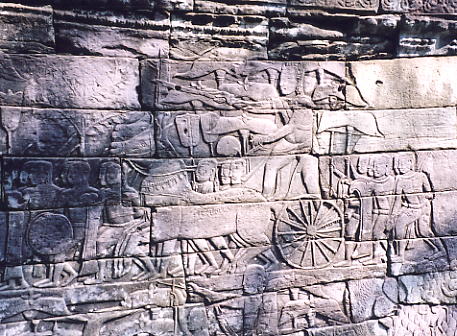 3.30pm and we had time to investigate just one of
the additional temples that India had described, situated a few
hundred metres behind the small market area and directly in line
with the temple's water-filled moat and southern gopura. We came
to what appeared to be a large pond, where young girls from the
village were gathering water in buckets and giggling at my
arrival, but it turned out to be a moat surrounding a
tree-festooned island where a giant Bayon-style face peered over
the treetops. One of the girls called the temple Prasat Prum
Mukbuon ('four faces'), another Ta Prohm, whilst Heang said he'd
heard both names on a previous visit but had never managed to
find the temple before. We walked around the laterite-stepped
moat until we came to a causeway to the island, where we met four
friendly youngsters, three girls, Sary, Chan and Bei, and Sophat,
who showed us a path through the dense vegetation to the large
tower at the centre.
3.30pm and we had time to investigate just one of
the additional temples that India had described, situated a few
hundred metres behind the small market area and directly in line
with the temple's water-filled moat and southern gopura. We came
to what appeared to be a large pond, where young girls from the
village were gathering water in buckets and giggling at my
arrival, but it turned out to be a moat surrounding a
tree-festooned island where a giant Bayon-style face peered over
the treetops. One of the girls called the temple Prasat Prum
Mukbuon ('four faces'), another Ta Prohm, whilst Heang said he'd
heard both names on a previous visit but had never managed to
find the temple before. We walked around the laterite-stepped
moat until we came to a causeway to the island, where we met four
friendly youngsters, three girls, Sary, Chan and Bei, and Sophat,
who showed us a path through the dense vegetation to the large
tower at the centre.
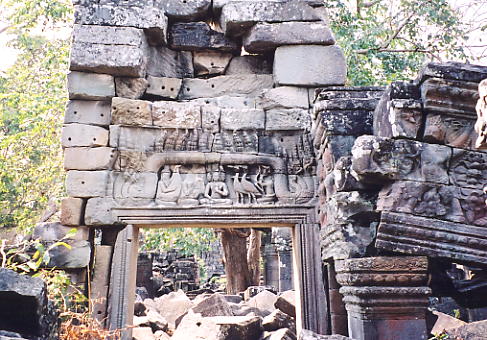 The sandstone structure reminded me of a slimmer
version of one of the main gates of Angkor Thom, with four
massive faces at the four cardinal points, still in very good
condition but lacking any lintels or pediments, whilst a large
sandstone pedestal was wedged into a hole in the ground directly
beneath the tower. One of the faces had lost its nose but apart
from that the faces - carrying a serene expression with closed
eyelids and thick, slightly curled lips - were identical to those
at the main Banteay Chhmar temple and the others built during the
glorious 12th century reign of Jayavarman VII, including the
Bayon and Ta Prohm. I shinned up to a ledge near one of the faces
for a view across the treetops to the wall and moat of the main
temple, five hundred metres away. Sary explained to Heang that
all the villagers nearby use the moat for their water supplies
and as she did one of the girls washing clothes shrieked loudly
as she prised a leech off her foot, to the amusement of her
friends. We left Prasat Ta Prohm and its likeable residents at
4pm, buoyed by our discovery and eager to return the following
day. The prospects were good if
The sandstone structure reminded me of a slimmer
version of one of the main gates of Angkor Thom, with four
massive faces at the four cardinal points, still in very good
condition but lacking any lintels or pediments, whilst a large
sandstone pedestal was wedged into a hole in the ground directly
beneath the tower. One of the faces had lost its nose but apart
from that the faces - carrying a serene expression with closed
eyelids and thick, slightly curled lips - were identical to those
at the main Banteay Chhmar temple and the others built during the
glorious 12th century reign of Jayavarman VII, including the
Bayon and Ta Prohm. I shinned up to a ledge near one of the faces
for a view across the treetops to the wall and moat of the main
temple, five hundred metres away. Sary explained to Heang that
all the villagers nearby use the moat for their water supplies
and as she did one of the girls washing clothes shrieked loudly
as she prised a leech off her foot, to the amusement of her
friends. We left Prasat Ta Prohm and its likeable residents at
4pm, buoyed by our discovery and eager to return the following
day. The prospects were good if  Ta Prohm was an example of the temples we were
likely to find. We called in at a roadside eatery in Thma Puok
for a cold drink and some friendly banter with two waitresses,
Tein and Neung, whom Heang knew well. Before we reached Sisophon,
the sky unexpectedly clouded over and it rained, a snake
slithered across the road centimetres from our front tyre and
Heang's moto developed a worrying clanking noise. At 7pm Noung
and Plon arrived and together with Heang and myself, took motos
to one of the popular lakeside restaurants over the bridge and
just outside of town on the road to Battambang, for a couple of
hours. Accompanied by live music, a string of female singers took
to the main stage of the restaurant, whilst we enjoyed a chicken
and beef feast in a wooden hut on stilts over the water. The rain
fell heavily throughout our meal, which at $12 for a substantial
spread and a steady flow of beers and soft drinks for the four of
us, was a fair deal. Noung and Plon were staying at the charity's
house in Ou Ambel, and I was starting early the next morning, so
I said goodnight a little after 9pm, with a promise to see them
again before I left Sisophon.
Ta Prohm was an example of the temples we were
likely to find. We called in at a roadside eatery in Thma Puok
for a cold drink and some friendly banter with two waitresses,
Tein and Neung, whom Heang knew well. Before we reached Sisophon,
the sky unexpectedly clouded over and it rained, a snake
slithered across the road centimetres from our front tyre and
Heang's moto developed a worrying clanking noise. At 7pm Noung
and Plon arrived and together with Heang and myself, took motos
to one of the popular lakeside restaurants over the bridge and
just outside of town on the road to Battambang, for a couple of
hours. Accompanied by live music, a string of female singers took
to the main stage of the restaurant, whilst we enjoyed a chicken
and beef feast in a wooden hut on stilts over the water. The rain
fell heavily throughout our meal, which at $12 for a substantial
spread and a steady flow of beers and soft drinks for the four of
us, was a fair deal. Noung and Plon were staying at the charity's
house in Ou Ambel, and I was starting early the next morning, so
I said goodnight a little after 9pm, with a promise to see them
again before I left Sisophon.
Heang
arrived at 6.30am the next morning for a noodles and coffee
breakfast at a busy cafe nearby and we left for our return visit
to Banteay Chhmar a little after 7am. The overnight rain had
dampened down the red dirt along route 69 and left small puddles
on the bumpy surface as we reached the temple site in exactly two
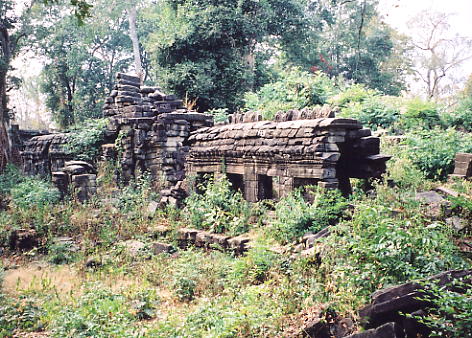 hours. At the entrance,
Heang explained our need for a guide to the policeman on duty and
moments later his fifteen year old son Sita arrived. Small for
his age, as most Cambodian youngsters are compared to their
western counterparts, and a little shy, he knew the whereabouts
of the seven satellite temples we'd come to find, the first of
which was just a hundred metres directly opposite the east
entrance. In an overgrown thicket behind some houses, a dry moat
surrounded an outer laterite wall and a jumble of fallen
sandstone blocks, two badly ruined towers and damaged partial
lintels on the ground. Sita called it Prasat Toch though it was
difficult to identify the layout of the temple because of the
dense vegetation. In the garden of the house where we left our
moto, we found the base of a carved colonette and then climbed
aboard Heang's moto and bounced further eastwards over a series
of rice fields and dykes towards a massive baray. At the top of
the laterite-stepped baray wall, we parked the moto at the home
of a monk and alongwith two small boys who joined us, walked a
kilometre across the dried rice fields to a large island in the
centre of the baray. A second circular island within the first
contained the temple we'd come to see, Prasat Mebon. The
undergrowth was pretty thick as we reached the first sandstone
sanctuary, partly ruined and minus a roof but with some wall
carvings of devatas and hermits, and a raised laterite causeway.
Nearby a larger sanctuary, also sandstone, was in slightly better
condition with beautiful circular patterns and Rishis (hermits)
carved on the doorframes and a small library amongst the ruins.
hours. At the entrance,
Heang explained our need for a guide to the policeman on duty and
moments later his fifteen year old son Sita arrived. Small for
his age, as most Cambodian youngsters are compared to their
western counterparts, and a little shy, he knew the whereabouts
of the seven satellite temples we'd come to find, the first of
which was just a hundred metres directly opposite the east
entrance. In an overgrown thicket behind some houses, a dry moat
surrounded an outer laterite wall and a jumble of fallen
sandstone blocks, two badly ruined towers and damaged partial
lintels on the ground. Sita called it Prasat Toch though it was
difficult to identify the layout of the temple because of the
dense vegetation. In the garden of the house where we left our
moto, we found the base of a carved colonette and then climbed
aboard Heang's moto and bounced further eastwards over a series
of rice fields and dykes towards a massive baray. At the top of
the laterite-stepped baray wall, we parked the moto at the home
of a monk and alongwith two small boys who joined us, walked a
kilometre across the dried rice fields to a large island in the
centre of the baray. A second circular island within the first
contained the temple we'd come to see, Prasat Mebon. The
undergrowth was pretty thick as we reached the first sandstone
sanctuary, partly ruined and minus a roof but with some wall
carvings of devatas and hermits, and a raised laterite causeway.
Nearby a larger sanctuary, also sandstone, was in slightly better
condition with beautiful circular patterns and Rishis (hermits)
carved on the doorframes and a small library amongst the ruins.
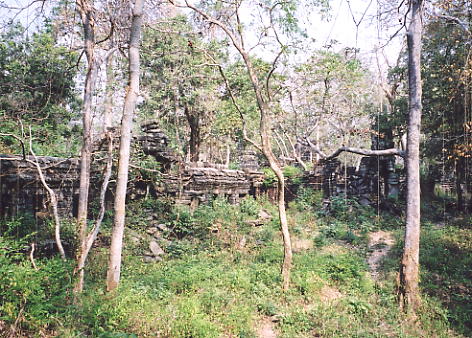 We returned to the village and stopped at Sita's
home to collect a machete. The undergrowth surrounding the
temples we'd visited was pretty thick and throny and the blade
and the long handle Sita fashioned from a piece of wood he found,
would prove to be invaluable. Following the large moat around the
main site, we turned northwards and came to Prasat Yeay Pum,
another sandstone temple surrounded by a laterite wall, with a
small pond, and obvious evidence of theft from the temple, with
blocks of sandstone containing the heads of carved Apsaras,
missing from the wall. The doorframes contained identical
circular carvings to those we found at Prasat Mebon. We continued
north for another five minutes and came to a large water-filled
moat and a seemingly impenetrable undergrowth-covered island. It
proved impossible to cut a way through the eastern approach, as
we came under attack from the spiky
We returned to the village and stopped at Sita's
home to collect a machete. The undergrowth surrounding the
temples we'd visited was pretty thick and throny and the blade
and the long handle Sita fashioned from a piece of wood he found,
would prove to be invaluable. Following the large moat around the
main site, we turned northwards and came to Prasat Yeay Pum,
another sandstone temple surrounded by a laterite wall, with a
small pond, and obvious evidence of theft from the temple, with
blocks of sandstone containing the heads of carved Apsaras,
missing from the wall. The doorframes contained identical
circular carvings to those we found at Prasat Mebon. We continued
north for another five minutes and came to a large water-filled
moat and a seemingly impenetrable undergrowth-covered island. It
proved impossible to cut a way through the eastern approach, as
we came under attack from the spiky  thornbushes, equally vicious red ants and itchy kha
pods, so we tried the western entrance, with more success. After
ten minutes of inching our way forwards with the machete, we
broke through the thick bush and entered the dark interior, under
a canopy of tall trees. Adjusting my eyes to the darkness and to
the large tower in front of me, I could make out a giant face.
The temple, which Sita called Prasat Chegnchemtrei, was similar
to Ta Prohm in the form of its main tower, though only two faces
remained, with two sides of the structure having fallen down. We
also found a broken sandstone gopura on the impenetrable eastern
side and a small laterite library. It was a difficult temple to
photograph clearly and the humidity under the umbrella of trees
was uncomfortable, but this was precisely the type of experience
and discovery that makes my temple exploration so exciting and at
times, challenging. It was 12.30pm, so we took a break and
stopped for lunch at one of the food stalls just behind the tiny
market by the southeast corner of the main moat. Heang, Sita and
myself settled in the shade and ate a beef, soup and vegetables
meal, washed down with the energy drink, Red Bull and tea.
thornbushes, equally vicious red ants and itchy kha
pods, so we tried the western entrance, with more success. After
ten minutes of inching our way forwards with the machete, we
broke through the thick bush and entered the dark interior, under
a canopy of tall trees. Adjusting my eyes to the darkness and to
the large tower in front of me, I could make out a giant face.
The temple, which Sita called Prasat Chegnchemtrei, was similar
to Ta Prohm in the form of its main tower, though only two faces
remained, with two sides of the structure having fallen down. We
also found a broken sandstone gopura on the impenetrable eastern
side and a small laterite library. It was a difficult temple to
photograph clearly and the humidity under the umbrella of trees
was uncomfortable, but this was precisely the type of experience
and discovery that makes my temple exploration so exciting and at
times, challenging. It was 12.30pm, so we took a break and
stopped for lunch at one of the food stalls just behind the tiny
market by the southeast corner of the main moat. Heang, Sita and
myself settled in the shade and ate a beef, soup and vegetables
meal, washed down with the energy drink, Red Bull and tea.
Refreshed
and fed, we carried on through the market in a southwest
direction for a few hundred metres. Behind some newly-erected
homes and in thick bushes, circled by a dry moat, was a sandstone
and laterite temple in very poor condition. Some walls and
doorframes remained standing but little else, with no decorative
features that I could find, and no evidence of a tower with
faces. The locals called it Prasat Yeay Chor. This was the only
temple we were to find not aligned to the four cardinal compass
points. We then moto'd along the south and west sides of the main
moat, before turning off and parking our moto behind a tree and
walked through fields to see our penultimate satellite temple,
Prasat Yeay Chy. Surrounded by a dry  moat, dense vegetation and a laterite wall, this was
another large gate tower with the faces of Jayavarman VII on two
sides, north and east, but missing from the other sides. Sita
pointed further west through the forest and across more fields
and five minutes later we arrived at another moat, this time with
water. The path into the complex of Prasat Samnang Tasok was
fairly straightforward aside from the ferocious red ants, so
standing still was asking for trouble. The floor of the site was
covered in thick bushes so it was easier to utilise the walls and
roof of the outer gopura to make our way to the central
sanctuary, which was topped by four more giant faces and other
carvings. Like the majority of the temples we'd located, apart
from the three of us, not another soul was anywhere to be seen
and the only sounds we heard were birdcalls and the occasional
rustle of a lizard amonst the undergrowth. On the way out, I was
perched precariously on the lintel of a gateway when two red ants
bit into my stomach after crawling up my trousers - I managed to
keep my balance, though this final warning from the 'guardians'
reminded me that temple exploration has a downside! We left at
3pm and stopped at the western entrance gate of the main Banteay
Chhmar temple, which was effectively a huge pile of sandstone
blocks. Sita met a friend at the gate and left us with my thanks
and a tip which he seemed pleased with, before we left the temple
for the final time, thoroughly satisfied that we'd uncovered some
hidden gems that will make a visit to this important Angkorean
site all the more interesting and challenging for visitors in the
future.
moat, dense vegetation and a laterite wall, this was
another large gate tower with the faces of Jayavarman VII on two
sides, north and east, but missing from the other sides. Sita
pointed further west through the forest and across more fields
and five minutes later we arrived at another moat, this time with
water. The path into the complex of Prasat Samnang Tasok was
fairly straightforward aside from the ferocious red ants, so
standing still was asking for trouble. The floor of the site was
covered in thick bushes so it was easier to utilise the walls and
roof of the outer gopura to make our way to the central
sanctuary, which was topped by four more giant faces and other
carvings. Like the majority of the temples we'd located, apart
from the three of us, not another soul was anywhere to be seen
and the only sounds we heard were birdcalls and the occasional
rustle of a lizard amonst the undergrowth. On the way out, I was
perched precariously on the lintel of a gateway when two red ants
bit into my stomach after crawling up my trousers - I managed to
keep my balance, though this final warning from the 'guardians'
reminded me that temple exploration has a downside! We left at
3pm and stopped at the western entrance gate of the main Banteay
Chhmar temple, which was effectively a huge pile of sandstone
blocks. Sita met a friend at the gate and left us with my thanks
and a tip which he seemed pleased with, before we left the temple
for the final time, thoroughly satisfied that we'd uncovered some
hidden gems that will make a visit to this important Angkorean
site all the more interesting and challenging for visitors in the
future.
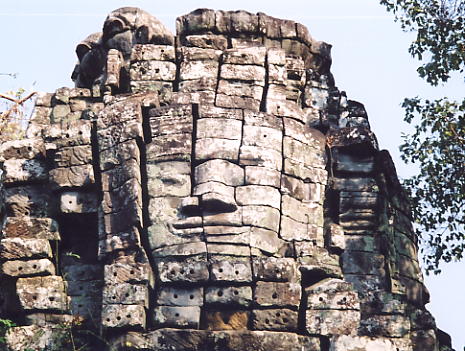 On the return journey, we
stopped at Thma Puok to chat briefly with Neung and Tein, before
arriving back in Sisophon at 5.30pm. We called into Heang's home,
where he used to live with his uncle's family before his recent
move to Siem Reap and then we drove out to Ou Ambel, a few
kilometres along the road to Poipet, to visit the charity
organisation where my friends Noung and Plon were staying. Noung
was feeling poorly after travelling to and from Poipet earlier in
the day - she's not a great traveller, as I reminded her of a
similar experience she had at Banteay Srei a few years before,
which at least cheered her up. We stayed for an hour before Heang
and I returned to town for a beef and fried rice meal at one of a
group of roadside restaurants, where he knew the husband and wife
proprietors. At the end of a long though highly successful day, I
returned to the Neak Meas hotel by 9pm, thanking Heang for his
invaluable co-operation during our journey of discovery. He'd
proved to be an excellent companion and driver and I would
recommend him to fellow travellers without any hesitation. In the
morning, I had breakfast at the Pkay Proeuk restaurant and took a
$5 backseat in a share-taxi bound for Siem Reap, that left
Sisophon market at 7.30am.
On the return journey, we
stopped at Thma Puok to chat briefly with Neung and Tein, before
arriving back in Sisophon at 5.30pm. We called into Heang's home,
where he used to live with his uncle's family before his recent
move to Siem Reap and then we drove out to Ou Ambel, a few
kilometres along the road to Poipet, to visit the charity
organisation where my friends Noung and Plon were staying. Noung
was feeling poorly after travelling to and from Poipet earlier in
the day - she's not a great traveller, as I reminded her of a
similar experience she had at Banteay Srei a few years before,
which at least cheered her up. We stayed for an hour before Heang
and I returned to town for a beef and fried rice meal at one of a
group of roadside restaurants, where he knew the husband and wife
proprietors. At the end of a long though highly successful day, I
returned to the Neak Meas hotel by 9pm, thanking Heang for his
invaluable co-operation during our journey of discovery. He'd
proved to be an excellent companion and driver and I would
recommend him to fellow travellers without any hesitation. In the
morning, I had breakfast at the Pkay Proeuk restaurant and took a
$5 backseat in a share-taxi bound for Siem Reap, that left
Sisophon market at 7.30am.
Here's links to the rest of my Cambodia Tales
January 2005 marked my eleventh trip to Cambodia since my first-ever visit in 1994. It's a country that has a special magic all of its own and which draws me back every year to venture out into the Cambodian countryside in search of new adventures, ancient temples and to catch up with the friends I've made from previous visits. Each trip is full of laughter, smiles and a host of fresh experiences and my latest expedition was no exception.
Home : Next : Messageboard : 2005 : E-mail
The contents of this website cannot be reproduced or copied without permission of the site author. (c) Andy Brouwer 2005
Click to enlarge all photos. Click 'refresh' if photos do not fully load.